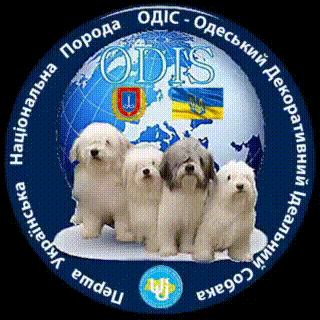

ODIS
Changes approved by the UKU Breeding commission on September 2, 2017
ODIS
TRANSLATION : UKU.
ORIGIN : Ukraine.
DATE OF PUBLICATION OF THE ORIGINAL VALID STANDARD : 09.11.2012
UTILIZATION: Companion Dog.
BRIEF HISTORICAL SUMMARY: The group of the dogs with the same ancestors and similar conformationwas formed in the result of the planned matings of the dogs of the breeds Fox Terrier, Miniature Poodle, Maltese and Chin in the end of the 70th in Odesa, Ukraine. Tamara Shargorodskaya, the UKU-FCI judge, initiated the creation of a breed group and in 2004 the formed breed was called ODIS and the breed standard was developed.
GENERAL APPEARANCE: Odis is a gay and lively dog with a bright temperament. It resembles to the South Russian Shepherd dog in appearance. The bone structure and body must be strongly built which is very important for this small dog, but it does not mean that Odis is clumsy, heavy or coarse. It is neither long-legged nor stumpy. Hindquarters move with plenty of drive and the forequarters have good reach. General measures, constitution and proportions are important. Its body is covered by the dense long hair of 7-15 cm with well-developed undercoat. Top hair on the head forms a forelock, whiskers and a beard. Tail is hanging down at rest, can be carried over the topline when the dog is excited.
IMPORTANT PROPORTIONS:
Height at withers: Ideal height for males – 37 cm. (with tolerance +/- 2 cm.).
Ideal height for females – 35 cm. (with tolerance +/- 2 cm.).
The depth of the chest: is half of the height at the withers.
Length of the head: is 40% of the height at the withers.
Length of the muzzle: is half of the length of the head.
Length index (Format): 110.
BEHAVIOUR / TEMPERAMENT: A sanguine dog.
HEAD: Head seen from above or from the side resembles to a blunt wedge. The distance measured from the occiput to the stop approximately equals to or a little less than the distance measured from the occiput to the nose.
CRANIAL REGION:
Skull: Slightly domed, moderately wide, gradually tapering to the eyes.
Stop is noticeable.
The superciliary arches and occiput are slightly developed.
Well-filled under eyes.
Jaw muscles are slightly developed.
FACIAL REGION:
Nose: The nose is wide; nostrils are well-developed. The nose is black for the dogs of solid white coat color, white with grey spots and grey coat colors. The dogs of the fawn coat color may have dark brown nose.
Foreface: Well filled, deep enough. Nasal bone is straight. Foreface is gradually tapering to the nose.
Lips: Tight-fitting, moderately thick, well pigmented.
Jaws/Teeth: Scissor or level bite. Jaws are strong.
Eyes: Of medium size, oval, dark, slightly oblique; eye rims are well pigmented.
Ears: Flat, lying closely to the skull, set on high, of medium size and reaching the eye line, slightly rounded at the tip.
NECK: Longer than the head, middle set, lean, gradually widening to the shoulders, well-muscled with tight skin, without dewlap; nape of the neck is well-pronounced.
BODY:
Topline: Firm, strong, slightly sloping from the well-pronounced nape to the pronounced withers and further along the level back turning into level loin and then into the slightly sloping croup.
Withers: Pronounced, well-muscled.
Back: Strong and straight, its length is half of the body length.
Loin: Short, muscled and level.
Croup: Short, slightly sloping, muscled.
Underline and Belly: Moderately tucked up.
Chest: The chest is sufficiently wide and oval in the cross-section, deep. The ribs are moderately sprung. Forechest is pronounced enough.
TAIL: Tail is hanging down at rest, can be carried over the topline when the dog is excited. Reaches the hocks by its length.
LIMBS
FOREQUARTERS: Seen from the front, parallel and widely set.
Shoulders: The shoulder blades are sloping.
Upper arm: Forming an angle of 100 degrees with the shoulder blade. Well-muscled.
Elbows: Parallel.
Forearm: Straight, upright, and well-muscled.
Carpus (Wrist): Lean, reasonably wide, in one plane with the forequarters.
Metacarpus (Pastern): Slightly sloping.
Forefeet: Oval, with slightly elongated middle toes, well-knit.
HINDQUARTERS: Parallel, not widely set. Seen from the side, are standing behind the vertical line drawn from the point of buttocks. Well angulated.
Upper thigh: Seen from the side, slanting.
Stifle: Pronounced.
Lower thigh: Slanting, well-musculed.
Hock: Well defined.
Metatarsus (Rear pastern): Vertical.
Hind feet: Round, arched and well-knit.
GAIT / MOVEMENT: Trot is typical. Movements are free, easy and straight.
SKIN: Sufficiently sick, elastic, without wrinkles or folds.
COAT
HAIR: Thick, long (7-15 cm) coat with well-developed undercoat all over the body. Top hair is moderately rough, long and slightly kicked; young and shedding dogs may have shorter hair. Top hair on the head forms a forelock, covering eyes and reaching the nose; whiskers and a beard. No trimming, which changes the dog’s shape, is allowed.
COLOUR: White, white with spots of various colours (except for liver), white with grey (blue), dark grey, fawn of various tints (except for orange).
FAULTS: Any departure from the foregoing points should be considered a fault and the seriousness with which the fault should be regarded should be in exact proportion to its degree and its effect upon the health and welfare of the dog.
- Height at withers:
Higher than 39 cm for males, and lower than 33 cm for females.
- Short forelock, not covering eyes.
- Poorly developed whiskers and beard.
- Spotted nose. At least ½ of the nose is pigmented.
- Too prominent light eyes.
- Ears short or turned back.
- Skull too domed.
- Too defined, steep stop.
- Not filled under eyes.
- Short, thin, loose neck.
- Low-set tail. Tail not reaching a hock joint. Tail carried over the back, curled in a circle, too short tail.
- Slightly defined withers.
- Week back.
- Excessively prominent loin.
- Steep croup.
- Somewhat straight angulation of hindquarters.
- Sickle hocks.
- Feet not arched enough.
- Bindy movements.
- Soft, too wavy hair.
SERIOUS FAULTS:
- Height at withers:
Lower than 33 cm or higher than 41 cm for males, and higher than 38 cm for females.
- Square body.
- Lack of forelock, whiskers and beard.
- Pricked ears.
- Light eyes.
- Spotted nose. Less than ½ of the nose is pigmented.
- Any color except for the standard ones.
- Big bright spots of various colors (liver, orange).
- Short, low set, loose neck.
- Undefined withers.
- Saddle back.
- Humped loin.
- Steep croup.
- Low set tail. Bobtail.
- Too sloping pasterns, weak pasterns.
- Buck knees.
- Too strait angles of hindquarters.
- Splay feet.
- Dewclaws.
- Heavy, bindy movements.
- Curly hair.
- Ectropion, entropion.
ELIMINATING FAULTS:
- Aggressive, overly shy.
- Cryptorchids or monorchids.
- Underdeveloped testicles.
- Not pigmented nose.
- Overshot, undershot.
- Ambling.
Any dog clearly showing physical or behavioural abnormalities shall be disqualified.
N.B. : Male animals should have two apparently normal testicles fully descended into the scrotum.


